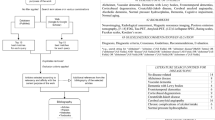Abstract
The use of neuroimaging is reviewed in the diagnosis of dementia, especially Alzheimer’s disease (AD). Computed tomography (CT) may be used to exclude other causes of dementia than AD. The finding of cortical or subcortical atrophy on CT or magnetic resonance imaging (MRI) itself does not indicate AD. Hippocampal atrophy on CT/MRI provides a useful early marker, although further longitudinal and neuropathological study is required. CT- and MRI-based measurements of hippocampal atrophy show promise in providing useful diagnostic information for discriminating patients with probable AD from normal elderly individuals. Using a standardized imaging protocol, including some assessment of hippocampal atrophy, can save costs since patients with suspected AD must undergo a cross-sectional imaging study to exclude other (treatable) causes of dementia. Combining an assessment of hippocampal atrophy with cerebral blood flow measurements by single photon emission computed tomography is not warranted either from a clinical or from an economic point of view.
Similar content being viewed by others
Author information
Authors and Affiliations
Additional information
Received: 4 November 1997 Accepted: 23 July 1998
Rights and permissions
About this article
Cite this article
Scheltens, P. Early diagnosis of dementia: neuroimaging. J Neurol 246, 16–20 (1999). https://doi.org/10.1007/s004150050300
Issue Date:
DOI: https://doi.org/10.1007/s004150050300




